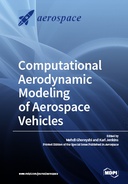Explore

Computational Aerodynamic Modeling of Aerospace Vehicles
Karl Jenkins and Mehdi Ghoreyshi
08.0
0 Ungluers have
Faved this Work
Login to Fave
Currently, the use of computational fluid dynamics (CFD) solutions is considered as the state-of-the-art in the modeling of unsteady nonlinear flow physics and offers an early and improved understanding of air vehicle aerodynamics and stability and control characteristics. This Special Issue covers recent computational efforts on simulation of aerospace vehicles including fighter aircraft, rotorcraft, propeller driven vehicles, unmanned vehicle, projectiles, and air drop configurations. The complex flow physics of these configurations pose significant challenges in CFD modeling. Some of these challenges include prediction of vortical flows and shock waves, rapid maneuvering aircraft with fast moving control surfaces, and interactions between propellers and wing, fluid and structure, boundary layer and shock waves.
Additional topic of interest in this Special Issue is the use of CFD tools in aircraft design and flight mechanics. The problem with these applications is the computational cost involved, particularly if this is viewed as a brute-force calculation of vehicle’s aerodynamics through its flight envelope. To make progress in routinely using of CFD in aircraft design, methods based on sampling, model updating and system identification should be considered.
Additional topic of interest in this Special Issue is the use of CFD tools in aircraft design and flight mechanics. The problem with these applications is the computational cost involved, particularly if this is viewed as a brute-force calculation of vehicle’s aerodynamics through its flight envelope. To make progress in routinely using of CFD in aircraft design, methods based on sampling, model updating and system identification should be considered.
This book is included in DOAB.
Why read this book? Have your say.
You must be logged in to comment.
Rights Information
Are you the author or publisher of this work? If so, you can claim it as yours by registering as an Unglue.it rights holder.Downloads
This work has been downloaded 490 times via unglue.it ebook links.
- 61 - pdf (CC BY-NC-ND) at Unglue.it.
Keywords
- aerodynamic performance
- Aerodynamics
- aeroelasticity
- after-body
- angle of attack
- bifurcation
- bluff body
- CFD
- characteristics-based scheme
- Chemistry
- computational fluid dynamics
- computational fluid dynamics (CFD)
- convolution integral
- CPACS
- DDES
- Detection
- discontinuous Galerkin finite element method (DG–FEM)
- dynamic Smagorinsky subgrid-scale model
- Euler
- flexible wings
- flow control
- flow distortion
- fluid mechanics
- flutter
- Formation
- gasdynamics
- Geometry
- Godunov method
- high angles of attack
- History of engineering & technology
- hybrid reduced-order model
- hypersonic
- installed propeller
- kinetic energy dissipation
- Large eddy simulation
- MDO
- meshing
- microelectromechanical systems (MEMS)
- Microfluidics
- modeling
- modified equation analysis
- multi-directional
- multi-fidelity
- MUSCL
- n/a
- neural networks
- numerical dissipation
- Numerical methods
- overset grid approach
- p-factor
- quasi-analytical
- RANS
- reduced order aerodynamic model
- reduced-order model
- Riemann solver
- S-duct diffuser
- sharp-edge gust
- shock-channel
- slender-body
- square cylinder
- subsonic
- Taylor–Green vortex
- Technology, engineering, agriculture
- Technology: general issues
- truncation error
- turbulence model
- unsteady aerodynamic characteristics
- URANS
- variable fidelity
- VLM
- vortex generators
- wake
- wind gust responses
- wind tunnel
- wing–propeller aerodynamic interaction
Links
DOI: 10.3390/books978-3-03897-611-0Editions


